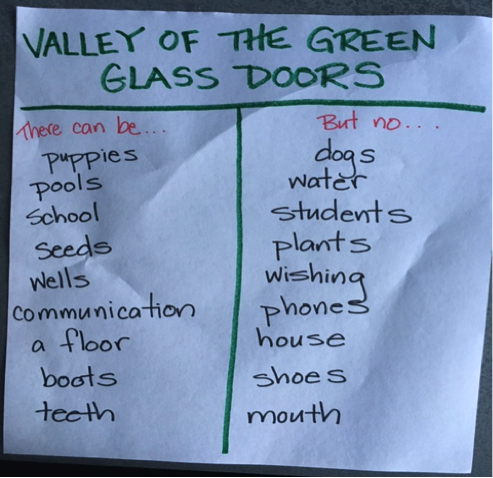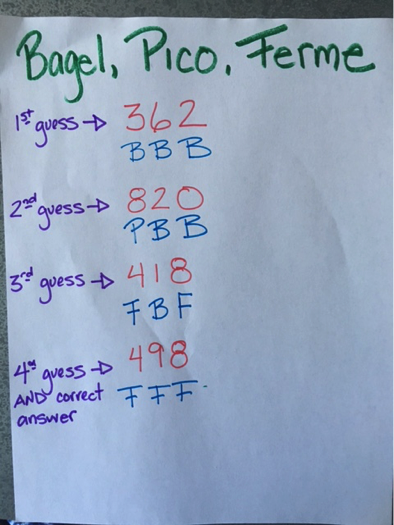Logic, Puzzles, Brain Teasers & Games
posted by Stephanie Forsman
I love playing games, doing puzzles, and figuring out a good brain teaser. I do the New York Times Crossword Puzzle everyday and while I struggle in the later half of the week, I love learning new information, keeping my brain sharp, and that sense of accomplishment after I have successfully completed a difficult puzzle. I try to instill this same love of logic puzzles in my students. We love to play, it’s how we learn.
Brain teasers, games, and puzzles boost brain activity, increase fluency and memory, improve concentration, promote harmonious group dynamics, and give one a sense of pride when they have successfully completed a challenge. I always have individual puzzles, such as Kenken or the “Find the Embedded Objects in the Picture”, like the ones in the old Highlights magazines, set out for my students when they finish their work early. I also engage the whole class in brain teasers in which they must work together to come up with the answer.
One of my favorite brain teasers is “Valley of the Green Glass Doors” taught to me by a former assistant who was a life-long camper and camp counselor. Many camp games translate well into the classroom. “Valley of the Green Glass Doors” is played with a group and I usually play it during Morning Meeting or at the end of the day. I begin by explaining that only certain things can be in the “Valley of the Green Glass Doors” and give examples such as, “There can be the MOON but no STARS…” I then give numerous examples. The key being that only words with double letters can be in the “vaLLey of the grEEn glaSS dOOrs.” I make a chart and have it hanging up for reference during the duration of the brain teaser.
At first, it is hilarious to listen to the children try and make sense of the logic. I usually need to provide some scaffolding by encouraging them to “think out of the box” and “try and different approach.” I also need to manage the frustration levels and keep the mood light and jovial which isn’t always easy to do.
Once someone figures out the pattern, they must check with me to see if they are correct and if they are, they then become the person to write down the correct answers and play the role of facilitator. They must also promise not to reveal the pattern to anyone else, which, as you can imagine, is also very difficult but prompts a worthwhile discussion on the benefits of working through a challenging problem on your own and not finding an easy way out when the going gets tough. I also have to inform the parents that we are playing this game and not to let the children go home and look up the answers on the Internet. This brain teaser can go on for several days. I recommend playing this with older students, 3rd & 4th grade. Each year, when I do my “End of the Year” reflection, “Valley of the Green Glass Doors” is always a highlight.
Another great brain teaser puzzle that is easier and we can play almost anywhere is “Bagel, Pico, Ferme.” The game begins with one person secretly choosing a number with no repeated digits. I usually start with a 3-digit number. The children attempt to guess the number, and the one who identifies the number correctly, becomes the next facilitator. For each guess that has no numbers correct, they respond: “Bagel.” If they guess a correct number but that number is in the wrong place, they respond: “Pico.” For each number the guess has correct and in the correct place, they respond: “Fermi.” In the beginning, I keep a chart to keep track of their responses but as they get the hang of the game, the chart no longer becomes necessary.
As an example, the number I think of is 489. I let the children know that I have thought of a 3-digit number and using the rules of “Bagel, Pico, Ferme” they will now take turns to figure out my number.
This game helps to improve memory and solidify place value. The children need to remember what number has already been used and in what place. I also use place value language by saying, “The 8 is a correct number but it is not in the hundred’s place” for the 2nd guess and then, “Yes, the 8 is in the one’s place” for the 3rd guess. This game is similar to the board game, Mastermind, is a game that I love and always have in my classroom.
Riddles are fun too! “Four is Magic” is my favorite and is fun to play once the kids have worked their way through “Valley of the Green Glass Doors” and know to look beyond the obvious.
3 is 5 is 4 is magic. Why is the number 3 the number 5? Why is 5 the number 4? Why is 4 magic?
Answer: 3 is 5 because there are five letters in the word three. 5 is 4 because there are four letters in the word five. 4 is magic because there are four letters in the word four.
http://www.ultimatecampresource.com/site/camp-activities/camp-games.html is a wonderful resource to find new games, brain teasers, and puzzles. Also, one of my favorite resources, Pinterest www.pinterest.com/explore/brain-games/. I also like to ask the children, many of them who attend camp or play games with their families if they have any they’d like to share.
One of the important things to remember when introducing and playing these games, brain teasers, and puzzles with your children is that there is a lot of teaching, managing, and emotional supporting that goes into these activities. The children need to essentially be “trained” in how to successfully master these activities. Have fun!


I never thought to add logic to my math curriculum. Thank you for reminding me. One of my favorite games growing up as a kid was Mastermind. Like your 3 digit math game, you chose four pegs (like in chinese checkers) and they are hidden, by matter of deduction, the other player gets 10 tries to figure it out. I’m going to dig that out and add it to my classroom this fall for sure!